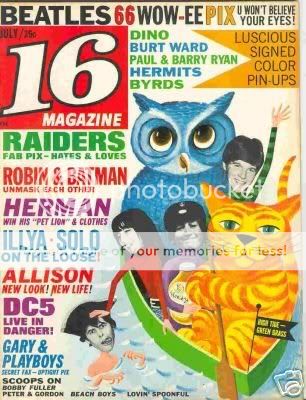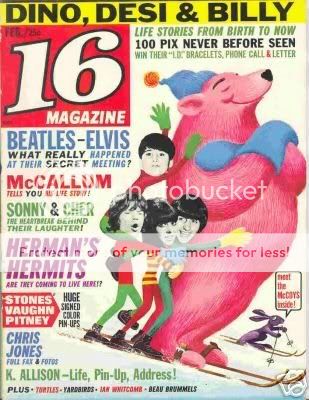Gloria Stavers
 Gloria Stavers was a young fashion model in 1957 when she took a job at 16 Magazine as a subscription clerk. Having enjoyed success as a runway and photographer’s model in the 1950s, she hung out with the New York jet set and was even rumored to have had a “relationship” with Mickey Mantle.
Gloria Stavers was a young fashion model in 1957 when she took a job at 16 Magazine as a subscription clerk. Having enjoyed success as a runway and photographer’s model in the 1950s, she hung out with the New York jet set and was even rumored to have had a “relationship” with Mickey Mantle.
But by the late ’50s, health problems stemming from a childhood bout with rheumatic fever and a bad back led Gloria to abandon modeling.
At a party, she met Jacques Chambrun and talked her way into a job answering the volumes of mail coming in from 16’s fanatical readers. Paid 50 cents an hour to process subscriptions, Gloria was happy to have a job, yet in her spare time, she studied the magazine extensively and sought to improve it.

Gloria noticed that the young girls writing in weren’t just in love with the idols of the day- Elvis, Pat Boone, Bobby Rydell- but they were also full of questions about how their heroes had become stars, how much money they really made, and how the recording process worked.
This led Gloria to reflect on how she was when she was 13 or 14 years old and of how insecure she was a teen. Putting herself into their shoes and mulling over what a star would be like- his favorite color, food, what hobbies he had, etc.- Gloria developed what later became a staple of 16 Magazine- “40 Intimate Questions.”
Armed with her questions, she took it upon herself to set up interviews with various press agents and to try her hand at being a journalist.
Her first interview was with Paul Anka and it proved to be a huge hit with her boss. She wrote, in part: One hundred and forty pounds of dark, handsome dynamite leaned back in his dressing room chair and smiled.
“Forty intimate questions?” he asked. “Boy! That means I have to tell all my secrets!”
And the fans ate it up, too. Jacques Chambrun did not fail to notice how sales rose with the “new” 16 Magazine and in late 1958, he appointed Gloria as editor-in-chief, a position she held for the next 17 years.

As the ’60s loomed, rock and roll was white hot and 16 led the charge. Every issue had some sort of “intimate” angle designed to hook young girls into buying the book – “Paul Anka: I Ran Away from Home!”, “I Was a Lonely Teenager” by Connie Francis, “The Kind of Girl for Me- Bobby Vee.”
The headlines screamed real issues that would appeal to the average girl, not just record sales figures and a schedule of concert stops like other magazines, but close and personal problems a girl could identify with. After all, if Annette struggled with her skin problems and with meeting boys, then maybe there was hope for the typical reader.
Throughout the ’60s and into the ’70s, Gloria’s power and influence continued unabated. Though she literally wrote the magazine herself (and took many of the photographs, using her model’s training to know what looked good), she became a virtual teen culture power broker.
Always putting her subjects in the best light, Gloria was seldom critical in her profiles, becoming an advisor for many and often a friend. Performers would call her for advice on film roles and TV appearances, on which single to release first, even about what to wear. They knew Gloria had her finger on the pulse of teen culture.
 She knew what was cool and was adept at spotting trends and the resultant crazes that followed. TV producers were even known to beg Gloria to instigate letter-writing campaigns with her readership to save their shows from cancellation.
She knew what was cool and was adept at spotting trends and the resultant crazes that followed. TV producers were even known to beg Gloria to instigate letter-writing campaigns with her readership to save their shows from cancellation.
The Saturday Evening Post in 1967, in a feature said this about her: “Record companies seek Gloria’s approval before launching publicity campaigns for their artists.” What power she yielded.
But despite all her influence, Gloria cared first and foremost about her readers. As the Post article attested, “Gloria takes her readers and their adolescent problems seriously. She lugs shopping bags full of mail home from the office and reads every one of the 300 personal letters she gets on an average day…The problems they have are so simple they bring tears to my eyes.
It’s not yet a question of whether to wear mini-skirts but how to say hello to a boy in the lunchroom…I get letters from girls who cry themselves to sleep every night because they’re so much in love with one Monkee or another.
Their parents think it’s silly or simply don’t believe them. Well, I believe them, and I know what they’re going through. It hurts. We try to help.”
Gloria Stavers Apartment – Sept. 1967





By the mid-’70s, Gloria had begun to seek other interests and eventually left 16 in 1975. Filling her time with freelance articles and her outlining a book about Jim Morrison and The Doors, she pursued more spiritual pursuits, studying Buddhism in her search for the “path” as she called it.
In 1982, Gloria was diagnosed with cancer and passed away in 1983.
Though Gloria had wined and dined with all the stars of the ’60s, rubbing elbows with the likes of The Beatles, Rolling Stones, Dave Clark Five, and virtually making Paul Revere and the Raiders into the rock and roll force they became, it was her lasting friendship with Peter Noone of Herman’s Hermits that saw her through her trying later years.
 With a sad ending worthy of a VH1 “Behind the Music” special, Peter relates, “When she got sick, (my wife and I) spent time with her, ferried her back and forth to the hospital. We’d run interference with the nurses who she just terrorized.
With a sad ending worthy of a VH1 “Behind the Music” special, Peter relates, “When she got sick, (my wife and I) spent time with her, ferried her back and forth to the hospital. We’d run interference with the nurses who she just terrorized.
What still astounds me is that aside from her personal friends, we were the only ones around. When she most needed people, she had all these people she’d done amazing things for…where were they? Had they all just used her, all the rock people?”
While to most of the world Gloria Stavers is an unknown, she was ostensibly the first female rock journalist and her influence is still felt to this very day. Countless fan magazines, to include entertainment types as People and Us, have her to thank for setting the bar a high as she did.
Once laughingly referred to as “Mother Superior to the Inferior” by the male-dominated publishing world, Gloria worried about her readers. The pop idols may have sold the magazine but the girls stayed because Gloria genuinely cared about all their other concerns.
As Peter Noone puts it, “Her lasting legacy, I think, can be summed up like this: Every gig I do now, somebody comes up to me with an old copy of 16- a photo of me holding a doll or something. Strange thing, isn’t it? The power 16 still has.” After 40+ years, it certainly does.
|
ladylimoncello wrote on Jun 23, ’08
Thanks for sharing this. I never knew of her before.
|
|
lauritasita wrote on Jun 23, ’08
I read 16 magazine, although I didn’t know much about Gloria Stavers. I knew she was the editor, but she must’ve kept a low profile. Nobody really talked about her, but I bet she was cool because she knew every rock star out there.
|
|
starfishred wrote on Jun 24, ’08
my little sis used to read her stuff thanks for sharing
|
|
lauritasita wrote on Jun 24, ’08
I loved all the cool articles about The Beatles, but I really loved this big spread she did on Jim Morrison one month. She did the whole thing in her apartment.
|


Comments
Gloria Stavers — No Comments
HTML tags allowed in your comment: <a href="" title=""> <abbr title=""> <acronym title=""> <b> <blockquote cite=""> <cite> <code> <del datetime=""> <em> <i> <q cite=""> <s> <strike> <strong>